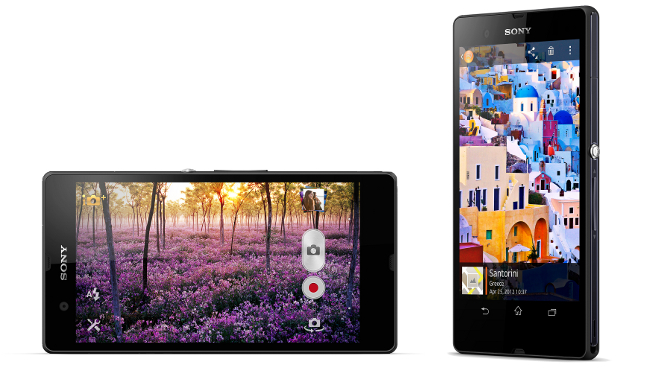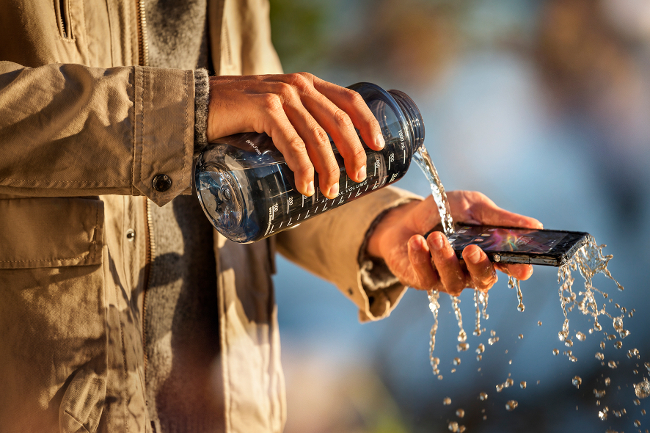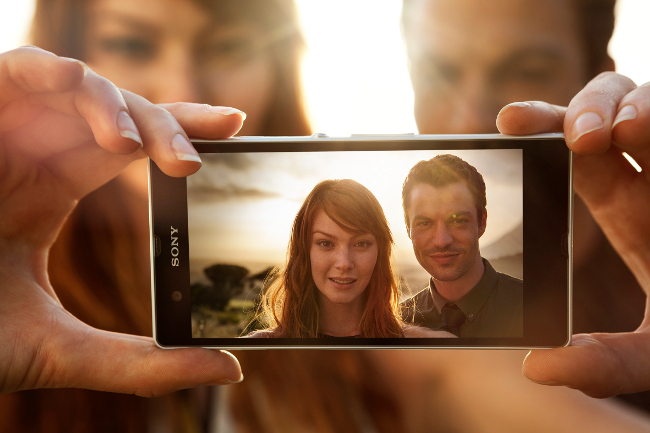Sony promises the best of its brand in the new Xperia Z smartphone, which comes in a durable waterproof and dustproof package. But did it stand up to our user tests?
Look and feel
Sony’s Xperia Z smartphone was first unveiled at CES 2013 and reaches us just five months after the release of the Xperia T, Sony’s former flagship model. While the so-called ‘Bond Phone’ sported a unique curved shape, the Xperia Z reverts back to Sony’s earlier, more standard flat design.
With glossy mirror-like surfaces on both the front display and the rear of the device, I often as to which side was which. The silver, centrally placed power button can’t be missed and adds interest to the design, while the gleaming edges appear a deep navy up close. This might be an issue for the extremely fashion conscious opting for the black version (isn’t there a rule against pairing the two?).
Despite its 5-inch display, Sony have still managed to keep the Xperia Z feeling light and compact at 146g, and just 7.9mm thick. Not only is the display larger than your average, it’s also a vast leap in terms of brightness and clarity compared to earlier and mid-range devices.

The full-HD Reality Display is stunning to behold, with a resolution of 1,080 x 1,920 (443ppi) providing super sharp detail that remains clear even in sunlight. As the Xperia Z promises ‘the best of Sony in smartphone’, what you’re getting with this display is the same contrast enhancement technology used in the latest Bravia TVs.
Durability
The glass surfaces on both the front and rear of the device are made of highly durable tempered glass and an anti-shatter film coats them, while the frame is made from tough glass fibre polyamide.
The Xperia Z claims the highest levels of dust and water resistance of any premium smartphone – and thankfully so, because like its predecessor its display attracts dust somewhat.

Every port on the Xperia Z (which includes a headphone jack, micro-SD slot, micro-SIM tray, and micro-USB connection) is sealed off so that the phone can survive underwater to a depth of 1m for up to 30 minutes. Unlike the unfortunate Xperia Go that fizzled out following our water test, the Xperia Z proved true to its word and survived its submersion without any issues.
While this doesn’t mean I’d go swimming with the phone tucked into my swimsuit, it does mean I wouldn’t be afraid of whipping it out in torrential rainfall – which we get all too much of in Ireland. Thankfully, the Xperia Z supports wet finger tracking for just such situations.
Features and performance
The Xperia Z has a full suite of connectivity options, with Wi-Fi, 3G and 4G for your internet services and DLNA, Miracast and NFC for connecting to other devices. Sony seems very keen on these last three technologies so expect their latest range of speakers, headphones, TVs – you name it – to be compatible with this smartphone.
Specifications
- Android 4.1.2 Jelly Bean
- 1.5GHz Qualcomm Snapdragon S4 Pro quad-core processor
- 16GB internal storage
- 2GB RAM
- 5-inch full-HD 1080p Reality Display with Mobile Bravia Engine 2
- Screen resolution: 1,080 x 1,920 pixels (443ppi)
- 2,330mAh battery
- 13MP rear camera with Exmor RS sensor for mobile, HDR video record
- 2.2MP front-facing camera, 1080p HD video record
The phone runs on Android 4.1.2 Jelly Bean, with an upgrade to 4.2 promised down the line. It features a generous 2GB of RAM and the 1.5GHZ quad-core processor is designed to use the device’s power wisely, powering up and down each core as needed.
The longevity of the Xperia Z’s 2,330mAh battery is also helped along by Battery Stamina mode. When enabled, this disables Wi-Fi and data and prevents apps from running in the background and draining battery power in standby. Using this mode I could potentially get days out of a single charge. Calls, texts, alarms and alerts still come through and users can decide which apps they want to continue running if needed.
As soon as you wake the display, everything should be up and running again as smoothly as if it had always been that way. However, the odd time I noticed some slight lag when jumping back in to apps from standby mode, but this is a rare niggle I can tolerate for the sake of extended battery life.
One thing I’m not as keen to tolerate, though, is slow web browsing. On a Wi-Fi connection the Xperia Z, which uses the Chrome app as its default browser, is fast to load, scan and zoom web pages. However, the performance dipped significantly when using my mobile data network. This being Ireland, I was using the 3G spectrum when out and about and perhaps the Xperia Z, being a 4G-ready device, is optimised for faster connections.
Call quality on the Xperia Z could also be better, especially when you’re working with a device that’s packing a lot more real estate between the earpiece and the mic.
Camera quality
The 13MP fast-capture camera from the Xperia T has been carried over into the new flagship. On the Bond Phone this was one of the highest-spec cameras available, though it’s quickly becoming a standard for newly announced top-of-the-line devices such as the Alcatel’s Idol X, LG’s Optimus G Pro and, perhaps, the Samsung Galaxy S IV.
One thing that hasn’t been kept from the Xperia T, though, is the dedicated camera button. I missed this and was sorry to see it hadn’t been included on the Xperia Z, seeing as it was one of my favourite features of the T.

The Xperia Z has an Exmor RS sensor for mobile, which has enabled it to become the first smartphone camera to accommodate HDR video recording. However, in my tests the HDR setting cast a green colour on the shot, which left me largely disappointed. This may have just a consequence of the conditions I was shooting in, but it highlights the fact that this technology will affect the on-screen picture.
The camera’s Superior Auto mode is apparently optimised for 36 different scenes and can automatically activate HDR and noise reduction as it deems they are needed. But recognising the scene seems to take time, so this mode isn’t ideal for a quick point and shoot.
The camera’s performance in low light was also less than I had hoped for as its noise minimisation tended to result in smudged detail, particularly for background objects.
The front-facing camera has seen a pixel upgrade to 2.2MP and is capable of recording 1,080p HD video – handy for selfies as well as high quality video calls .
Verdict
Overall, the Xperia Z is a powerhouse of a smartphone with a dazzling display and long-lasting battery. There are features of the Xperia T that I wish Sony held on to – such as the curved design and the dedicated camera button – but the Xperia Z is a fine premium model for anyone on the market for a large-scale Android device without stepping all the way up to the dimensions of Samsung’s Galaxy Note range.
Plus, you have the added benefit of knowing your precious device won’t be damaged by a downpour, and that reassurance is golden.
The Sony Xperia Z is available now from all Carphone Warehouse stores nationwide, from free on bill-pay with €50 off on all networks, and from €529 on pre-pay